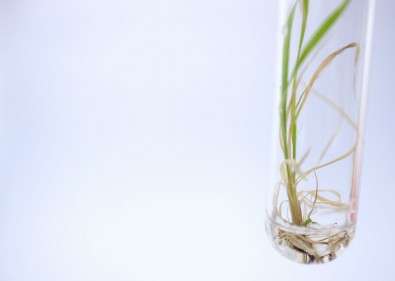Study reveals how a hormone increases sucrose accumulation in sugarcane

Chemical ripeners, also known as growth regulators, are widely used in Brazil's sugarcane industry to increase early sucrose content relative to total mass and to inhibit plant growth in order to prolong harvesting and milling, thereby increasing yields and profitability for plantation owners.
A group of researchers at the University of Campinas's Biology Institute (IB-UNICAMP) in São Paulo State, in collaboration with colleagues at the Agronomy Institute (IAC) and at the University of São Paulo's Chemistry Institute (IQ-USP), have now discovered how these substances, which are analogous to plant hormones, act on the molecular level in sugarcane to increase sucrose storage in the plant.
An article describing the study has been published in Scientific Reports, an online journal owned by Springer Nature.
"We identified genes that are activated by one of the most widely used chemical ripeners and that could be targets for future manipulation by genetic engineering in order to try to develop a sugarcane variety with higher sucrose content," said Marcelo Menossi, a professor in IB-UNICAMP's Genetics, Evolution & Bioagents Department and principal investigator for the project.
The researchers analyzed the molecular-level effects of the application of ethephon to sugarcane varieties grown in a greenhouse.
Ethephon is an ethylene-releasing compound and was the first growth regulator used for crop management and post-harvest quality in a wide range of agricultural, horticultural and forestry species. In the case of sugarcane, it remains one of the most widely used substances to stimulate ripening, increase sugar yield, inhibit flowering, and extend the harvesting and milling seasons.
The effects of ethephon on sugarcane are attributed to ethylene, a plant hormone known for its involvement in fruit ripening. Ethephon releases ethylene as it penetrates the plant after spraying.
Ethylene is therefore considered key to a better understanding of the regulation of the transition from plant growth to cane maturation, according to Menossi.
"Although ethylene was known to contribute to sucrose accumulation, it wasn't clear how the synthesis and action of this hormone affect cane maturation," he said.
To study the action of ethylene in sugarcane, before the onset of ripening, the researchers sprayed a sugarcane variety developed by IAC with ethephon and aminoethoxyvinylglycine (AVG), a growth regulator known to inhibit ethylene biosynthesis.
Five days after spraying the plants with one of the two compounds and again after 32 days (i.e., at harvest time), they measured sucrose content in samples of leaf and culm tissue.
The analysis showed that ethephon, the chemical ripener, stimulated sucrose accumulation in immature internodes. Plants treated with ethephon displayed higher sucrose levels in upper and middle internodes at harvest time.
By contrast, sucrose content fell 42 percent in plants treated with AVG.
"These findings confirm the importance of the presence and action of ethylene to induce cane maturation," Menossi said.
In order to evaluate the action of ethylene at the molecular level, the researchers analyzed the plant transcriptomes to identify which genes were differentially expressed in response to ethylene release during maturation. The transcriptome is the full range of messenger RNA molecules expressed. Transcriptome analysis enables researchers to determine when and where each gene is turned on or off in the cells and tissues of an organism by analyzing the entire collection of RNA sequences.
Their analysis of the transcripts of the main enzymes involved in sucrose metabolism regulation, combined with the hormone profiles of the plants sprayed with ethephon and AVG, enabled them to identify ethylene target genes and the action of ethylene in sucrose accumulation sites. In addition, they proposed a molecular model for the interaction of ethylene with other hormones.
Ethylene activated a significant number of hormone pathway genes solely in the culm. The key hormone pathways were those involved precisely with ethylene and also with abscisic acid, another factor in cane maturation, as well as gibberellin and auxin, hormones that influence culm elongation, flowering and lateral bud growth, Menossi explained.
"If you know which genes the ripener modulates so that the plant increases sucrose accumulation, you can genetically improve the sugarcane and develop varieties that express more of these genes without needing to apply ethylene, for example," he said.
"In addition, it could be possible to identify sugarcane varieties that express these genes most highly and to facilitate the action of the ripener, since there are varieties that don't respond well to hormone application."
More information: Camila P. Cunha et al. Ethylene-induced transcriptional and hormonal responses at the onset of sugarcane ripening, Scientific Reports (2017). DOI: 10.1038/srep43364
Journal information: Scientific Reports
Provided by FAPESP



















